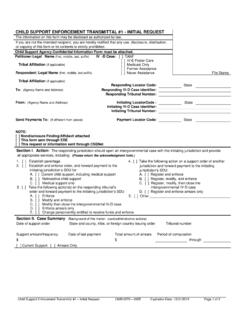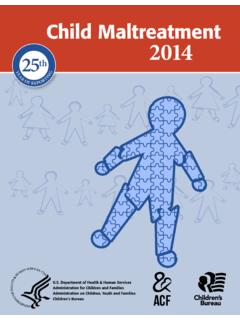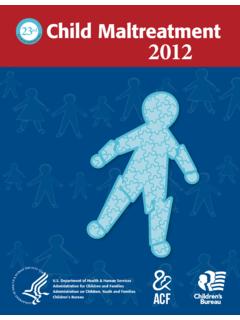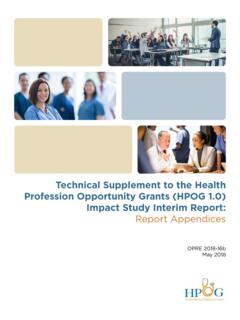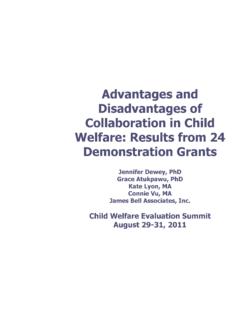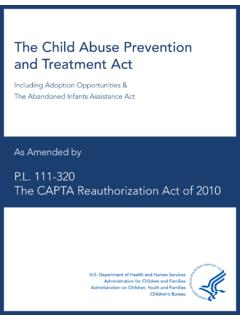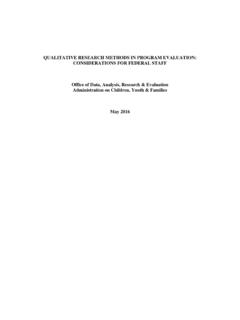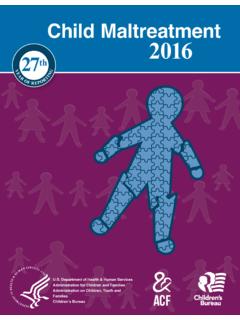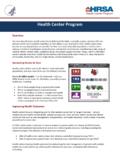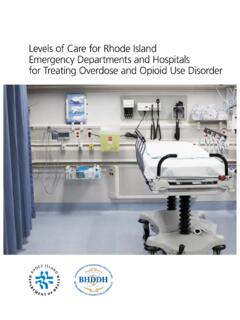Transcription of A National Look at the Use of Congregate Care in …
1 Department of Health and Human ServicesAdministration for Children and FamiliesAdministration on Children, Youth and FamiliesChildren s BureauA National look at the Use of Congregate care in Child Department of Health and Human Services, Administration for Children and Families, Children s BureauMay 13, 2015 EXECUTIVE SUMMARYF ederal, state, and local agencies have focused on the placement settings and services experienced by children and youth who experience foster care . Current federal policy about the appropriate use of placement settings is limited. Federal law mandates that each child s case plan must include a discussion of how the child s case plan is designed to achieve a safe placement for the child in the least restrictive (most family-like) setting available and in close proximity to the home of the parent(s) when the case plan goal is reunification.
2 Case plans must also address how the placement is consistent with the best interests and special needs of the child (section 475(5)(A) of the Social Security Act, CFR (g)(3)). However, states have flexibility and discretion to make decisions for a child on a case-by-case basis to ensure that the best placement is made and the individual needs of the child are there is an appropriate role for Congregate care placements in the continuum of foster care settings, there is consensus across multiple stakeholders that most children and youth, but especially young children, are best served in a family setting. Stays in Congregate care should be based on the specialized behavioral and mental health needs or clinical disabilities of children. It should be used only for as long as is needed to stabilize the child or youth so they can return to a family-like setting.
3 There has been a significant decrease in the percentage of children placed in Congregate care settings in the past decade, and this reduction is at a greater rate than the overall foster care population. According to the most recent data available, children spend an average of 8 months in Congregate care . While these trends suggest that child welfare practice is moving toward more limited use of Congregate care , the depth of improvement is not consistent across states, and some cohorts of children and youth have fared better than others. This data brief is designed to help policymakers and advocates at the state and federal level better understand the population of children and youth who are likely to experience Congregate care and what, if any, additional supports may be needed to further reduce reliance on it as a placement setting for certain cohorts of children and youth.
4 In order to provide a basic understanding of the use of Congregate care and to paint a picture of the children who are placed in these settings, we analyzed a number of data elements from the Adoption and Foster care Analysis and Reporting System (AFCARS). In addition to a review of quantitative data, we highlight strategies that a number of state and local jurisdictions have used to increase the effectiveness of Congregate care , shorten lengths of stay, and develop alternative placements. IIUsing descriptive statistics and limited logistic regression analyses to better understand the children who experience time in Congregate care , we found that children with a DSM11 The Diagnostic and Statistical Manual of Mental Disorders (DSM) is the standard classification of mental disorders used by mental health professionals in the United States.
5 Diagnosis, behavioral health issues, or clinical disabilities other than a DSM diagnosis made up a significant proportion of those children who, at some point during their time in foster care , experienced time in a Congregate care setting. Using this Clinical Disabilities 22 The AFCARS definition of clinical disabilities includes mental retardation, visually or hearing impaired, physically disabled, emotionally disturbed (DSM diagnosis), and other medical condition requiring special care ( , in most cases, these chronic illnesses requiring ongoing medical care ). The operationalized AFCARS definition requires that these disabilities be professionally diagnosed. information and the Child Behavior Problem (CBP) as a circumstance associated with the child s removal and placement into foster care , we developed four mutually exclusive subgroups for analyses: Subgroup 1 (No Clinical Indicators), Subgroup 2 (DSM Indicator), Subgroup 3 (CBP Indicator), and Subgroup 4 (Disability Indicator).
6 QUANTITATIVE RESULTSThis brief examines the use of Congregate care from both point-in-time (PIT) and first-time-entry cohort perspectives. PIT analyses provide a snapshot of child welfare caseloads on any given day. A first-time-entry cohort perspective provides a longitudinal look at the experiences of children entering care at a particular time to better understand their total time in PIT analyses allow us to see how Congregate care is being used for all children in care on September 30, 2013 ( , the last day of the federal fiscal year (FFY) 2013). We use these analyses to answer the question What is the difference between children who do and do not experience Congregate care ? We find that: Children in Congregate care settings are almost three times as likely to have a DSM diagnosis compared to children in other settings.
7 Children in Congregate care settings are more than six times more likely than children in other settings to have child behavior problem as a reason for removal from home. On average, children spent a total cumulative amount of 8 months in a Congregate care setting compared to an average time in a particular placement type of 11 months for children in other accounts for placement moves and provides a better picture of the actual overall time spent in a setting of time was calculated by totaling all time in a particular placement type during the course of a child s entire first removal episode. This The overall time in foster care was longer for children who spent some time in Congregate care , with an average of 28 months compared to 21 months total time in foster in the Congregate care PopulationProportionately, children in Congregate care comprised 18 percent of the foster care population in 2004 and 14 percent in 2013 a notable decrease.
8 Additionally, over the past 10 years, the number of children and youth in the child welfare system on the last day of the FFY declined by 21 percent, from 507,555 in 2004 to 402,378 in 2013. Comparatively, the number of children in care on the last day who were placed in a group home or institution decreased by 37 percent (a decline from 88,695 to 55,916). Congregate care use is decreasing at a greater rate than the overall foster care population, which indicates states are making greater strides in reducing the number of children who spend time in a Congregate care Trends in Congregate care UsePIT numbers can over represent youth who have been in care for longer time periods and youth who enter care toward the end of the FFY. Therefore, we followed three cohorts of youth for 5 years from the time they entered foster care for the first time in FFY 2006, 2007, and 2008.
9 This allows for a better understanding of how many new entries into Congregate care occur in a given with the PIT analyses, all three cohorts were examined using our four-subgroup divisions. Of those who experienced some time in Congregate care , on average about 41 percent were in Subgroup 1 (No Clinical Indicators), 20 percent in Subgroup 2 (DSM Indicator), 32 percent in Subgroup 3 (CBP Indicator), and 7 percent in Subgroup 4 (Disability Indicator). Given these similarities among cohorts, additional Congregate care analyses only are reported for the most recent cohort (children and youth followed from 2008 to 2013). A National look at the Use of Congregate care in Child WelfareIIIA National look at the Use of Congregate care in Child WelfareSimilar to the PIT results, the majority of the children in the 2008 cohort did not spend long periods of time in a Congregate care setting.
10 Thirty-six percent spent 60 days or less in Congregate care . Five percent spent 61 to 90 days, and an additional 35 percent spent 91 days to 1 year in that setting. Close to one-quarter (24 percent) spent more than 1 year in Congregate care . On average, they spent 9 months in a Congregate care setting (close to the PIT average of 8 months seen above); over one-third (34 percent) spent more than 9 Age 12 and YoungerChild development theory, federal legislation, and best practice confirm what we know intuitively children should be placed in settings that are developmentally appropriate and least restrictive. For young children, particularly those age 12 and under, it is particularly important for their developmental needs to be met in family-like settings. As such, we would expect to see very low percentages of children age 12 and under in a Congregate care setting.
